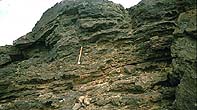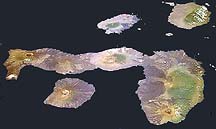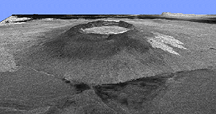
Shield volcanoes are broad, low-profile features with basal diameters that vary from a few kilometers to over 100 kilometers (e.g., the Mauna Loa volcano, Hawaii). Their heights are typically about 1/20th of their widths. The lower slopes are often gentle (2-3 degrees), but the middle slopes become steeper (~10 degrees) and then flatten at the summit. This gives shield volcanoes a flank morphology that is convex in an upward direction. Their overall broad shapes result from the extrusion of very fluid (low viscosity) basalt lava that spreads outward from the summit area, in contrast to the vertical accumulation of airfall tephra around scoria-cone vents, and the build-up of viscous lava and tephra around stratovolcanoes. Cross-sections through shield volcanoes reveal numerous thin flow units of pahoehoe basalt, typically < 1 m thick. Pyroclastic deposits are minor (< 1%) and of limited dispersal, generally from flank eruptions associated with parasitic scoria cones, or from rare, localized hydrovolcanic eruptions.
 |
Very thin pahoehoe flow units (< 0.5 m thick) on the flank of a shield volcano in western Saudi Arabia. Photo by Vic Camp. |
The Mauna Loa volcano on the Big Island of Hawaii, seen here in both a oblique and satellite views, is the world's largest shield volcano:

|

|
|
|
|
Shield volcanoes are generated by Hawaiian eruptions. However, there is some variability in their eruptive style, which translates into variations in shield morphology and size. The almost perfect symmetry and small volume (~15 km3) of Icelandic shields, for example, stands in marked contrast to the elongation and huge volume (thousands of km3) of Hawaiian shields. These variations are largely attributed to the monogenetic, small-volume, centralized summit eruptions, typical of icelandic shields, and the polygenetic, large-volume, linear fissure eruptions, typical of most hawaiian shields. Still different are the symmetrical Galapagos shields, shown below, which have steep middle slopes (>10 degrees) and flat tops occupied by large and very deep calderas. These shield types appear to be generated by ring-fracture eruptions, which delineate the sides of the caldera and mark the site of caldera collapse.
 |

|
|
of the Galapagos Islands |
the Alcedo shield volcano on Isabella Island, Galapagos |
Go to: